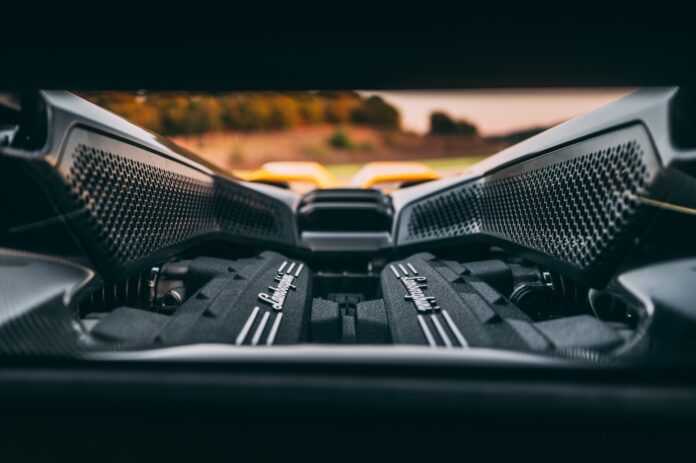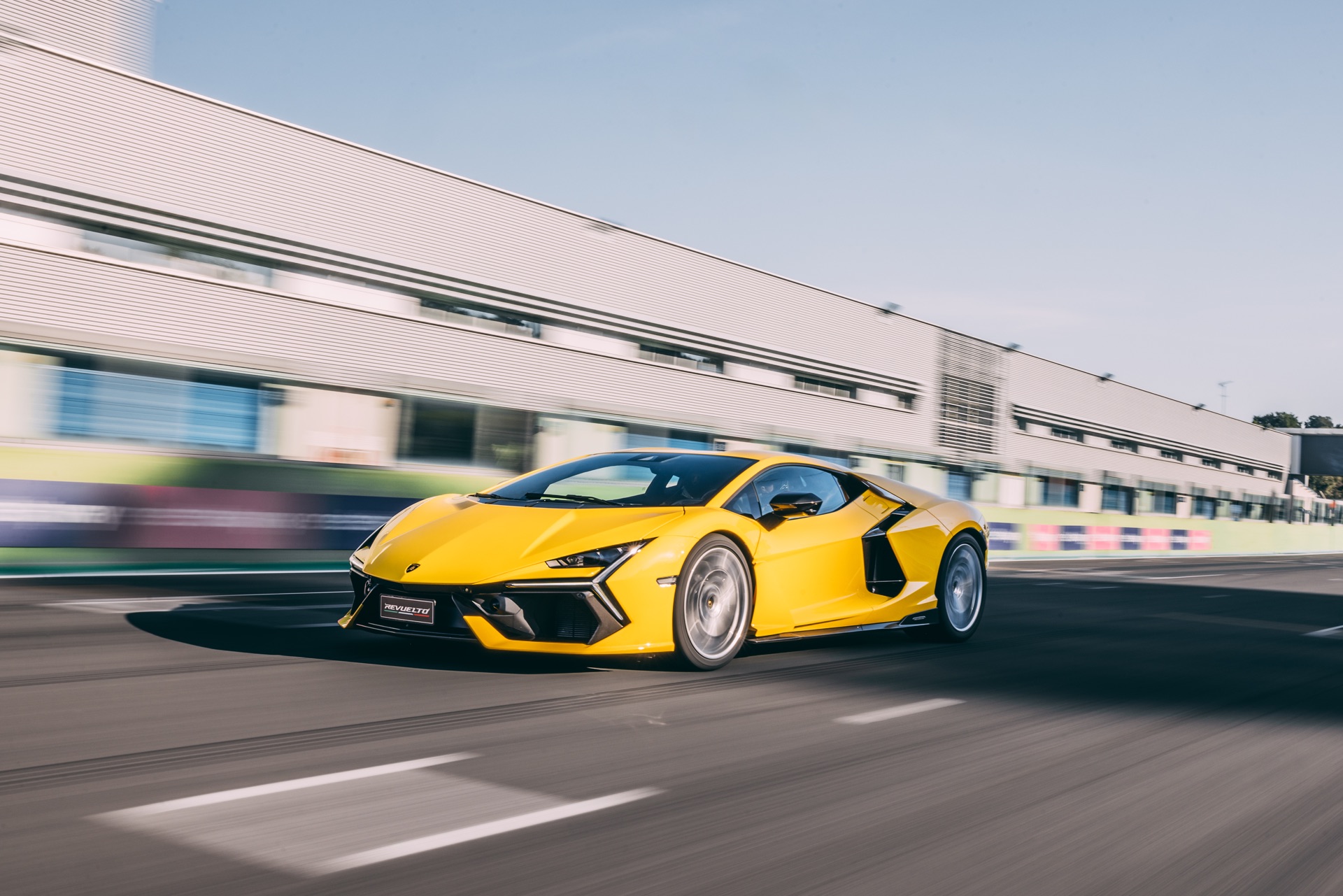In a time when several super sportscars have already surrendered to electricity, the Aventador’s successor does use electric power but as a way to postpone the retirement of the naturally aspirated V12 engine (and making it possible for thew Revuelto to start the day “on slippers”, avoiding waking up the neighbours). 200 km/h in 7 seconds or 350 km/h (in addition to the 13 km electric range) are printed on its business card. But they only tell a small part of the story.
Stephan Winkelmann, Lamborghini´s CEO, and his small team of executives, are proud to know their customers well (in many cases even personally, although with the – likely – new record of 10,000 cars registered in a year this is becoming more difficult). “The new Revuelto is a milestone in the history of Lamborghini and will become an icon in the history of super sports cars by redefining the limits in the combination of a new V12 engine with hybrid propulsion technology, bridging the gap between the excitement our customers are not willing to give up, and the imperative need to reduce emissions”. The promise seems to have resonated with customers of the raging bull brand, as “almost 2.5 years of production of the Revuelto sold out even before the first driving impressions of the car were published”, rejoices Federico Foschini, VP of sales and marketing of the Italian brand. In other words, the annual production of some 1500 units (7 to 8 cars per day) already found their owners, meaning newly interested customers will have to accept waiting until mid-2026, even if they write a check tomorrow.
This is, therefore, the first model of Lamborghini’s future. From now on all its cars will be partially or fully electric: the arrival of the Urus PHEV in 2024 and the successor to the Huracan before the end of next year, also with a plug hybrid V8 powertrain, are confirmed. But you also notice the Revuelto is starting a new era when you look at the cockpit, with features a new infotainment generation inside a newly designed dashboard, with technology from the Urus, but also from other VW Group models such as the Porsche Cayenne or the Audi A6, among others.
4 (engines) in 1
To face a growing competition from electric hyper sports cars with powers peaking all the way up to 2000 ps, Lamborghini engineers defined a number for the Aventador’s successor maximum output: above 1000 ps, more specifically 1015 ps (and 725 Nm) delivered by the combination of the two power sources (the naturally aspirated V12 engine and three electric motors, one for each front wheel and a third behind the engine, on the rear axle). And, with the help of the new 8-speed dual-clutch automatic transmission (replacing the previous 7-speed robotised manual) and the four-wheel drive system, the power to weight ratio of just 1.75 kg/ps (the best ever in a street legal Lamborghini), the Revuelto is capable of sprinting to 100 km/h in 2.5 seconds, blasting to 200 km/h in just 7 seconds and finally stopping at the unintelligible mark of 350 km/h, at which point the 12 cylinders are close to their maximum rotation speed of 9500 rpm.
In other words, the fastest series production Lamborghini ever… and also the one with the best handling, as Rouven Mohr, Lamborghini’s CTO (Chief Technical Officer) confirmed to me, at the end of this test drive at the Vallelunga racetrack (in the outskirts of Rome): “on a lap in Nardo, with the same tires, the Revuelto is 3 seconds faster than an Aventador SVJ”.
With a monocoque and several body elements (front and rear bonnet and roof) in carbon fibre (the scissor doors are in aluminium to avoid expensive repair bills from damages while opening/closing), it is as martial you would expect in a Lamborghini super sports car. At the front there are structural elements in forged composite materials, giving rise (together with the monocoque) to what Italian and German engineers (working for Lamborghini) call the “monofuselage” and which is inspired by the world of aeronautics. It is said to allow significant gains in terms of weight and torsional rigidity and, as a result, the Revuelto is 10 percent lighter than the Aventador chassis and the front structure is 20 percent lighter than that of its predecessor (made of aluminium).

At the same time, torsional stiffness increased by 25 percent, reaching 40,000 Nm/degree, with benefits in the vehicle´s dynamics.
It’s difficult to remain indifferent in front of this squat body riddled with creases, very large air intakes, LED headlights and a large brake light that subtly illuminates the rear of the imposing V12 (for the first time completely uncovered) under braking, to create a scenic spectacle worth being contemplated. The longitudinally mounted “mechanical heart” (rotated 180 degrees in relation to the position in the Aventador) is left visible, visually relating to the double hexagonal exhaust pipe tips placed in the highest position ever on a Lamborghini (and above which reigns the wing with a geometric profile), flanked by the optics with Y light signature.
And, in absolute respect for a tradition that began with the first Lamborghini with a V12 engine – the 1971 Countach – the famous scissor-opening doors also define the Revuelto’s strong personality.
Clear Progress Inside
Inside, the sports bucket seats are covered in leather (or Dinamica polyfibre) – Lamborghini is working to offer vegan leather “soon” – and there is a 12.3-inch instrument panel. Mitja Borkert, design director at Lamborghini, highlights the “feel like a pilot” philosophy the Revuelto’s cockpit aims to create where driver and passenger are integrated into the Y-shaped dashboard/centre console, replicating the sensations experienced aboard a jet fighter, but with an intuitive balance between digital and physical controls.” As tradition goes, there is visible carbon fibre on the dashboard, door panels and air vents.
In the centre of the console there is a second 8.4-inch digital screen for everything related to infotainment and, as in the Ferrari rival, for the first time the passenger also has direct access to the most important information through his own 9.4-inch display. And, in a way that is as practical as it is fun, information or applications can be transferred from the central display to either side displays with the simple movement of two paired fingers, as on some smartphones. This being just one of the advances resulting from the quantum leap that was made in terms of connectivity in this transition from the Aventador to the Revuelto.
The four small rotary controls mounted on the steering wheel spokes are used to select the driving modes (Cittá, Strada, Sport and Corsa), the battery modes (Recharge, Hybrid and – with Sport and Corsa – also Performance), the elevation of the car’s nose (by 3 cm to avoid contact between the front with the ground) and the rear spoiler angle (it can be done manually but also adjusts automatically, depending on the selected drive mode, flat for maximum speed, elevated to help with braking functions and improve downforce). “This means that the driver has 13 different general settings at his disposal depending on the driving scenario and the type of driving he wants to adopt”, concludes Mohr.
Maximum power varies depending on the selected drive mode: 180 ps in Cittá, 886 ps in Strada, 907 ps in Sport and a total of 1015 ps in Corsa, when the battery program is in Performance; in this case it will evaporate all its “juice” after a few minutes (but always keeping a reserve to ensure that, even in electric mode, there is always 4×4 traction available). In Recharge position, energy recuperation increases to restore the state of charge and in Hybrid mode the charge level is kept (it can be useful when entering an urban area, even if the range is only 13 km). In this regard, Matteo Ortenzi, director of the Revuelto product line-up, clarifies that “it would have been possible to use a larger battery for 100 km range but this would add at least a hundred kilos to the car´s overall weight and the purpose here was to offer a super sports car but with electric power to lower emissions and improve performance, not to make an ordinary plug-in hybrid.” On the other hand, it would be problematic to enlarge the battery too much considering that it is installed in the central longitudinal tunnel, where the Aventador had the transmission shaft and gearbox, and where there wasn’t much space left (although the automatic transmission was moved to the rear of the engine, mounted transversely, making this only the third “Lambo” in history with this layout: the other two being the 1966 Miura and the 2020 hyper-sports car Essenza SCV12 (exclusively for the track and in a limited 40 unit production).
Even though interior space is not one of its main attributes, the Revuelto offers an additional 2.6 cm in headroom (thanks to the domed shape at the either side of the roof) and an additional 8.4 cm in legroom (the wheelbase increased by 8 cm). A golf bag now fits behind the seats, just as two cabin suitcases fit under the front bonnet.
A Huge “Heart”
While the engine (which weighs 218 kilos, 17 less than the Aventador’s) 6.5 litre, naturally aspirated V12, worth 825 ps, thunders behind the two occupants’ heads with its credits firmly established by the sensational specific power of 127 ps/litre), two 150 ps (110 kW) axial-flux electric motors (each weighing 18.5 kilograms) hiss at the front axle while producing an additional 350 Nm of torque each. A third electric motor, with the same output of the other two, was installed in the automatic transmission housing. The three electric motors are brought to life by a small 3.8 kWh battery that can be charged in 30 minutes via a 7.4 kW plug, through regenerative braking or directly via the V12 engine.
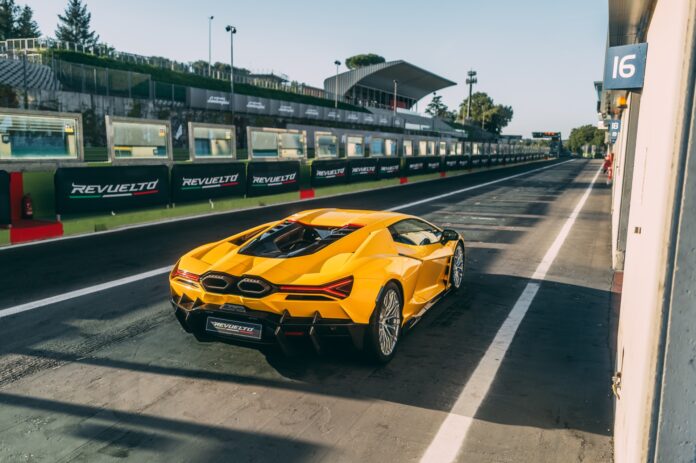
It’s easy to admit that the total of 13 driving programs will impress even the most experienced drivers, but the truth is that the possibilities for using the Revuelto are very numerous, ranging from just 180 ps (electric) in the city to a maximum 1015 ps with the four power sources giving it all in Corsa mode. The mass distribution is 44:56, with a predominance towards the rear axle (only marginally more balanced than in the Aventador Ultimae, where it was 53/47). Ceramic discs are standard equipment.
Any proper super sportscar has to be pushed to the ground and “slip through the air”. The new active rear wing is fundamental to the Revuelto’s dynamics, changing its position according to the selected drive mode or by the driver’s own manual selection. When the idea is to drive only electrically and promote efficiency, the flat position (low drag) ensures minimum resistance to the vehicle’s motion, while the “high aerodynamic load” position produces the opposite effect, helping to glue the car to the road. With the contribution of the Revuelto’s optimized front design, Italian engineers speak of an increase in aerodynamic load by 33 percent in the front and 74 percent in the rear, compared to the Aventador Ultimae.
Lapping Vallelunga
The Vallelunga racetrack, 32 kilometres north of Rome, was chosen by Lamborghini for the first media test drives of the Aventador, in 2011, and has now once again become the stage for its successor’s baptism of fire. But now with lots of sun and a dry track, contrary to what had happened back then. It’s a 4 km track with 15 curves, some of which are very fast, almost straights just asking for slight steering corrections, even at the crazy speeds that the Revuelto can reach: in my case, I was informed by the instructor driver (in front of me with another Revuelto) that our top speed was 275 km/h after the long straight that precedes turn 7 (Campognano). Good thing he told me because I only had eyes for the track limits, apexes, correct lines and the controls in front of me. It is not that difficult as the most relevant switches are placed on the thick rimmed Alcantara covered steering wheel (from the gear shift paddles, to the four rotary buttons, as explained before).
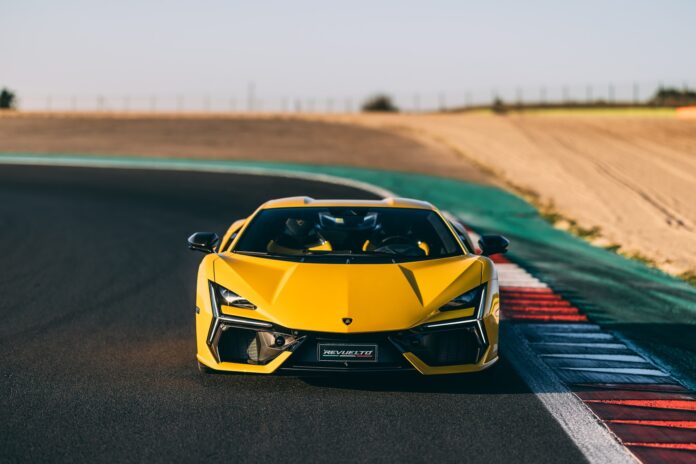
There were four stints in total, four laps each: the first for launching, the next two were warm to hot laps and the last half lap used to cool down tires, brakes, engine and faster battery recharging). That is equivalent to a fast-driving distance slightly below 50 kilometres, with the recommended breaks to “process” the learnings and exchange impressions with the engineers and the pro-driver who saw all the action from his rear mirror.
Having established this the fastest and most powerful Lamborghini ever built, stating the Revuelto is unbelievably fast is not really breaking news. With a similar length but being 6 cm narrower and 3 cm lower than the Aventador, there was no way around the 160 kg weight increase even with the replacement of some aluminium chassis parts with carbon fibre ones and the use of an electronic inverter to initiate reverse gear (meaning there no mechanical gear for this). The new 8-speed dual-clutch automatic transmission is heavier than the previous 7-speed automated manual and, small as it may be, the lithium-ion battery also carries weight and there are three electric motors more than in the Aventador (which had none).
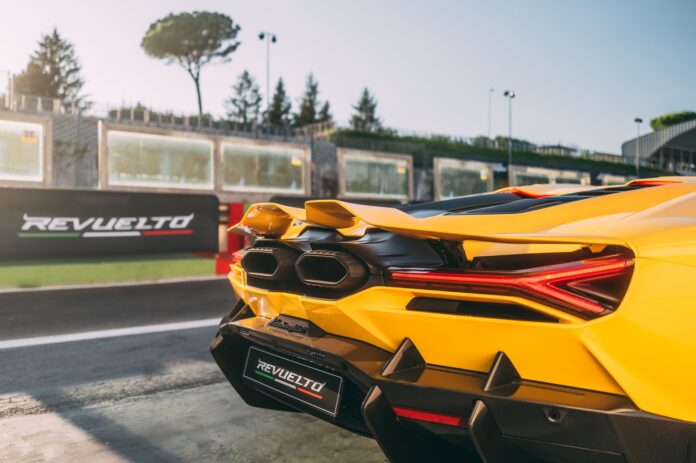
What is the downside of the weight increase, to 1772 kilos? None. Weight/power ratio is more favourable (from 1.99 to 1.75 kg/ps), the car is much more agile through corners thanks to rear axle steering (avoiding impacting dynamics due to the increased 8 cm wheelbase) and, of course, consumption is considerably lower. The figures will be homologated later but based on Lamborghini’s target to produce emissions some 35 percent lower than those of the Aventador, we are looking at an WLTP average of some 12.5 litres/100 km (and 288 g/km CO2). It’s not a low figure, but much lower than before.
The Big Misconception
Even if the idea of needing a mere 7 seconds to go from a standstill to 200 km/h is a disturbing as fascinating, the truth is that there are other remarkable attributes in the dynamic envelope of the Revuelto. Starting with the sensational V12 stealing the show with the dramatic audio soundtrack, also due to the lack of any glass or plastic film covering it. But also, how easy and intuitive it easy for a driver with some experience, but with no supernatural pro-driver skills, to lap at an incredible fast pace just after a few corners which are also very useful to learn the track. The initial ballistic acceleration occurs with the urgency of a non-existing turbo engine, replicated by the instantaneous torque delivered by the electric motors, and then the fluid breathing of the naturally aspirated V12 (which at 9250 rpm is still loaded with stamina, as the injection cut off only comes at 9500) ensures that there is life far beyond 6500 rpm (after which even the best turbo engines start to fade away).
And how does it handle through corners? Yet again, it’s likely that in the driver´s mind a big misconception may be generated as he is fooled into thinking he´s got what it takes to be a racing driver. Brake power, made possible by large ceramic discs, is brutal, always with a very strong initial “bite” and with no signs of fading after long and intense use, confirms the targets set by the CTO were achieved, as Roven Mohr himself underlines at the end of the drive session: “it’s a new braking philosophy, with a stronger deceleration in the beginning, so that the driver can then manage the speed suitable for each point on the track”. The higher downforce (a 66 percent increase compared to the Aventador) also helps to stick the Revuelto to the road.
Then, the four power sources “get along” in the best possible way, delivering power to the front and rear with no jerks or hesitations and apparently able to serve exactly the power each is able to digest, without choking. Equivalent to say, with no wheel slip as long as some criteria and common sense are used. The explanation, once again coming from the man in charge of Lamborghini engineering, seems simple: “we limit the intervention of the stability control system to the maximum, avoiding selective wheel braking, which always makes driving less fluid. And we end up generating torque vectoring electrically, slightly increasing the power delivered to the inner wheel when entering the corner and doing the same to the outer wheel when exiting, to benefit stability and handling.” This means that brake intervention is only carried out in extreme situations, if it becomes absolutely necessary.
This is the first super sportscar on the market with active torque vectoring and rear axle steering and this combination translates in an exquisite combination of precision, agility and fluidity. This is also possible thanks to the very small rear wheel rotating angle which avoids the sensation that the front and rear wheels are doing different things in a given moment, known as the “forklift effect”). The rear wheels may turn 3 degrees in parking manoeuvres (reducing the turning diameter, important in urban scenarios in a car which is almost 5 meters long) and only 0.1 to 0.2 degrees dynamically.

The Bridgestone Potenza Sport tires on matching rims (265/35 ZR20 in the front and 345/30 ZR21 in the rear) help “the cause” and the same can be said about the much smoother, more fluid and faster dual-clutch gearbox compared to the virile (and even violent, in Corsa mode) manual automated transmission from the Aventador, which finally retired.
In the end, all that was left to prove was the Revuelto’s road handling, but this was not the time (still pending homologation and the cars available so far don´t even have street legal license plates. On the other hand, the use of stiffer stabilizer bars may lead to a more uncomfortable ride, but the electronic shock absorbers should be responsible for compensating and ensuring minimum rolling comfort, at least in the more compliant Cittá and Strada modes.
